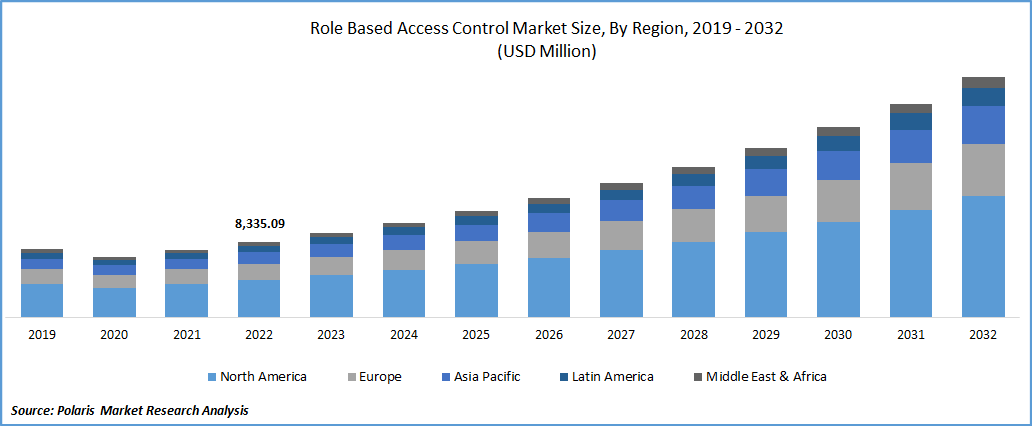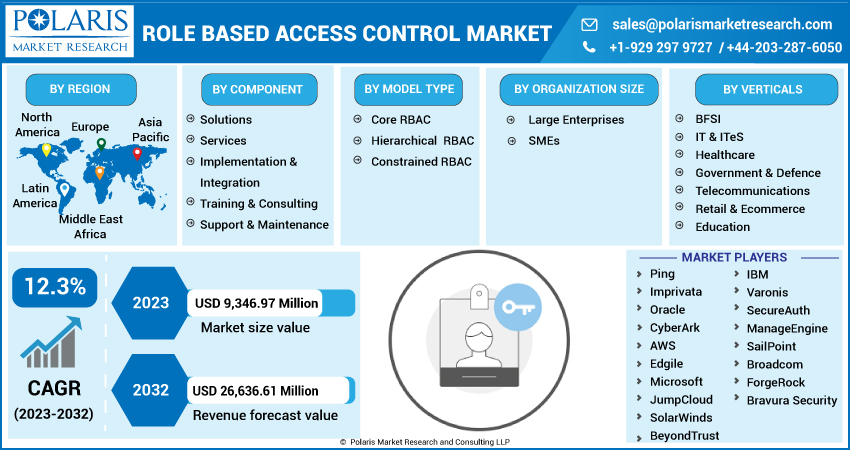
Role Based Access Control Market Share, Size, Trends, Industry Analysis Report
By Component; By Model Type; By Organization Size; By Verticals; By Region; Segment Forecast, 2023- 2032
- Published Date:Jul-2023
- Pages: 118
- Format: PDF
- Report ID: PM3462
- Base Year: 2022
- Historical Data: 2019-2021
Report Outlook
The global role based access control market was valued at USD 8,335.09 million in 2022 and is expected to grow at a CAGR of 12.3% during the forecast period. The global market is experiencing significant growth due to the increasing need for security solutions across various industries. RBAC solutions help organizations ensure that only authorized individuals have access to sensitive information, systems, and resources, becoming increasingly important as cyber threats continue to rise. The use of RBAC is also gaining popularity in organizations that operate in highly regulated industries, such as healthcare and finance, where compliance with strict data protection regulations is critical. RBAC solutions provide a means to manage access to resources based on user roles and responsibilities, enabling organizations to maintain compliance and protect sensitive data from unauthorized access.

To Understand More About this Research: Request a Free Sample Report
For instance, In June 2022, Microsoft introduced Microsoft Entra, a comprehensive solution that includes all of Microsoft's identity and access management capabilities. The offering comprises Azure AD and two new product categories, Microsoft Entra Permissions Management and Microsoft Entra Verified ID, designed to deliver secure access to users in the digitally connected world.
Moreover, the increasing adoption of cloud computing has led to a greater need for RBAC solutions to manage access to cloud-based resources and data, and the growing trend of remote work and the need for secure access to corporate resources has led to increased demand for RBAC solutions. RBAC can help organizations streamline access control processes, reduce manual intervention, improve efficiency, enhance security posture, and comply with regulatory requirements.
COVID-19 has impacted the (RBAC) market significantly, as there has been an increasing need for remote work and the adoption of cloud-based solutions, resulting in a surge in demand for (RBAC) solutions. With a growing number of employees working remotely, organizations require efficient and secure ways to manage access to their resources and data, and the pandemic has also highlighted the importance of data privacy and security, making RBAC an essential component of organizations' security strategies and driving the market growth.

For Specific Research Requirements, Request for a Customized Report
Industry Dynamics
Growth Drivers
The role based access control market is driven by increasing security and compliance concerns. Considering rising cyber-attacks and data breaches, organizations are adopting advanced security measures to protect their critical assets and sensitive information. RBAC is gaining popularity in managing resource access based on user roles and responsibilities within an organization. Many industries, including healthcare and finance, have regulations that require the use of RBAC for compliance with data protection requirements. RBAC enables these organizations to manage access to information, ensuring compliance with rules and enhancing data security and privacy.
Furthermore, the growth of the RBAC market is further driven by the increasing adoption of cloud technology. As more organizations migrate to the cloud, RBAC has become a critical tool for managing access to cloud-based resources and data. By implementing RBAC, organizations can ensure that only authorized users can access these resources, reducing the risk of data breaches and unauthorized access. In addition, there is a growing demand for automation in various industries, including IT, which has increased the need for RBAC. RBAC can help streamline access control processes, reducing manual intervention and improving efficiency. Therefore, RBAC is increasingly becoming an essential component of identity and access management (IAM) strategies for organizations seeking to automate their operations.
Report Segmentation
The market is primarily segmented based on component, model type, organization size, verticals, and region.
|
By Component |
By Model Type |
By Organization Size |
By Verticals |
By Region |
|
|
|
|
|
To Understand the Scope of this Report: Speak to Analyst
The support & maintenance segment experienced fast growth at a high CAGR in 2022
The Support & Maintenance segment experienced fast growth at a high CAGR due to its essential role in providing ongoing technical support, maintenance services, and training to ensure the RBAC system operates securely and efficiently. The increasing demand for RBAC systems reflects the growing recognition among organizations of the importance of securing their data and resources. As the RBAC market grows, the Support & Maintenance segment will become increasingly vital in ensuring that the RBAC system remains up-to-date and effective in mitigating evolving cybersecurity threats. The rise in cyber threats and the need for robust security measures are rapidly driving market growth.
Furthermore, the software segment is significantly contributing to the growth of the RBAC market by providing organizations with software solutions that enable them to manage user access and permissions more efficiently, thereby reducing the risk of data breaches. With the increasing reliance on digital platforms and the need for secure data access. This segment includes on-premises software, cloud-based software, and hybrid solutions, which are becoming increasingly popular due to their ability to integrate with other security technologies and drive market growth rapidly.
Core RBAC segment held the largest market share in 2022
The core RBAC segment held the largest market share in 2022. This is attributed to the core RBAC model's simplicity makes it easier to assign roles to users and regulate their access to sensitive information and resources. Additionally, it can be customized to meet the specific needs of different organizations, allowing for greater flexibility and adaptability. Organizations favor the core RBAC model for its effectiveness in enhancing security measures by reducing the risk of data breaches and other security threats. Its widespread adoption, simplicity, flexibility, and security effectiveness contribute to its dominance in the market.
Large enterprise segment held the significant market revenue share in 2022
The large enterprise segment held a significant market revenue share in 2022 and is expected to drive future market growth due to its ability. This can be attributed to large enterprises, which refer to businesses with over 1,000 employees, tend to be early adopters of (RBAC) solutions, as they typically utilize multiple applications that are susceptible to fraudulent attacks. Implementing RBAC in these organizations enables them to systematically manage access privileges across dispersed entities and enforce standardized policies. This helps ensure regulatory compliance and facilitates the provision of appropriate access to users to carry out their job responsibilities.
Moreover, the small and medium-sized Enterprises (SMEs) segment is considered the fastest-growing sector in the global market, which typically employs fewer than 500 employees, are increasingly recognizing the need for these solutions to protect their business operations from the rising incidences of cybersecurity threats as it provides the ability to manage access control policies systematically, assign least privilege permissions to users, and enforce regulatory compliance, among other benefits. Additionally, the vendors are developing solutions tailored to the specific needs and budget constraints of SMEs, making these solutions more accessible and attractive to these businesses.
North America dominated the global market in 2022
North America region dominated the global market in 2022. This can be attributed to the widespread adoption of RBAC solutions by businesses in the region and the significant number of key RBAC vendors operating in this region. The need to adhere to strict regulatory requirements and combat high cybersecurity threats has further propelled the demand for RBAC solutions in this region. The increasing adoption of RBAC solutions by businesses and the need to comply with regulatory requirements and protect sensitive data are driving the growth of the market globally.
Furthermore, The Asia-Pacific (APAC) region is expected to experience significant growth in the coming years, leading to increased demand for RBAC solutions. This growth can be attributed to businesses' increasing adoption of RBAC solutions and a growing awareness of the importance of implementing access control measures. Additionally, the need to comply with data privacy regulations and the rising utilization of cloud computing are key factors that are expected to drive market growth at a high rate in the region.
Competitive Insight
Some of the major players operating in the global market include Ping, Imprivata, Oracle, CyberArk, AWS, Edgile, Microsoft, JumpCloud, SolarWinds, BeyondTrust, IBM, Varonis, SecureAuth, ManageEngine, SailPoint, Broadcom, ForgeRock, and Bravura Security.
Recent Developments
- In July 2022, Bosch Security released Access Management System 4.0. This updated version features numerous integration options and has enhanced security measures. It also offers new features such as biometric verification, license plate recognition, and elevator dispatch systems to improve cybersecurity protection against potential cyber-attacks.
- In March 2021, Okta, a leading identity management company, announced the acquisition of Auth0, an authentication and authorization solutions provider. The addition will enhance Okta's RBAC capabilities and expand its customer base.
Role Based Access Control Market Report Scope
|
Report Attributes |
Details |
|
Market size value in 2023 |
USD 9,346.97 million |
|
Revenue forecast in 2032 |
USD 26,636.61 million |
|
CAGR |
12.3% from 2023 – 2032 |
|
Base year |
2022 |
|
Historical data |
2019– 2021 |
|
Forecast period |
2023 – 2032 |
|
Quantitative units |
Revenue in USD million and CAGR from 2023 to 2032 |
|
Segments covered |
By Component, By Model Type, By Organization Size, By Vertical, By Region |
|
Regional scope |
North America, Europe, Asia Pacific, Latin America; Middle East & Africa |
|
Key companies |
Ping, Imprivata, Oracle, CyberArk, AWS, Edgile, Microsoft, JumpCloud, SolarWinds, BeyondTrust, IBM, Varonis, SecureAuth, ManageEngine, SailPoint, Broadcom, ForgeRock, and Bravura Security. |
FAQ's
The global role based access control market size is expected to reach USD 26,636.61 million by 2032.
Key players in the role based access control market are Ping, Imprivata, Oracle, CyberArk, AWS, Edgile, Microsoft, JumpCloud, SolarWinds, BeyondTrust, IBM, Varonis, SecureAuth, ManageEngine.
North America contribute notably towards the global role based access control market.
The global role based access control market is expected to grow at a CAGR of 12.3% during the forecast period.
The role based access control market report covering key segments are component, model type, organization size, verticals, and region.
